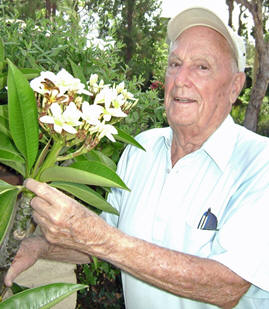Obituary Notice Seymour Dean Van Gundy
(1931-2020)
 |
Seymour Dean Van Gundy passed away peacefully at home on 27 December
2020. He was born on 24 February 1931 in Toledo, Ohio.
Known to family, friends and colleagues as ‘Van’, he graduated from
Monclova High School, Monclova, Ohio, in 1949. Van entered Bowling Green
State University on an Edwin Mosley Scholarship and graduated with a
B.A. in Biology in 1953. While an undergraduate, he worked part-time at
the local H.J. Heinz Crop Research Department crossing tomatoes and
cucumbers and screening cucumbers for cucumber scab resistance under a
collaborative programme with the Department of Plant Pathology,
University of Wisconsin. Plant Pathologist J.C. Walker offered him an
assistantship to continue his work on cucumber angular leaf spot when he
graduated in 1953.
In 1956 Van finished his Ph.D. research at the University of
Wisconsin and continued as a postdoctoral student until February 1957.
Dewey J. Raski, Chair of the University of California Statewide
Nematology Department, offered him a position in the Nematology
Department at UC Riverside. Two months of training with esteemed
nematologist Gerald Thorne prepared Van for his new job before going to
California.
|
He joined the UCR Department of Nematology as a junior nematologist in March
1957. At that time, the management and damage control of nematodes attacking
citrus in southern and central California was of significant economic interest.
In 1958, Van researched and published the first complete life history of the
citrus nematode (Tylenchulus semipenetrans). Consequently, he worked
for many years on the ecology and management of citrus nematodes. Nearly a
decade later, he discovered the sheath nematode (Hemicycliophora arenaria),
a new species parasitising desert citrus. With the campus photographer, Ken
Middleham, they made the first nematode film featuring the feeding and life
cycle of the sheath nematode. In 1964, he was named a Fellow of the American
Association for the Advancement of Science (AAAS). Van was appointed Professor
of Nematology in July 1968.
During the 1965-1966 academic year, Van spent a sabbatical leave in Australia
working with Harry Wallace and Alan Bird to strengthen his interdisciplinary
research interest in nematode ecology. In collaboration with UCR colleagues in
various departments, Van continued to study resistance in citrus to the citrus
nematode, the interaction of multiple nematode associations on citrus and
grapevines and the effects of soil aeration on the ecology of nematodes. He
worked with Peter Tsao and Donald E. Munnecke (Department of Plant Pathology,
UCR) on soil fungi/citrus nematode interactions and soil fumigants,
respectively. From September 1968-1970, he served as Associate Dean for Research
in the Graduate Division at UCR.
From 1970-1972 Van served as Assistant Vice Chancellor for Research, and from
1972-1984 he was Chairman of the Department of Nematology. Through his lobbying
efforts, he secured State funding for the first Nematology Quarantine and
Isolation facility. In 1977, in collaboration with Diana Wall, he spent a summer
at the University of Alaska, Fairbanks, to study nematodes in the black
spruce-permafrost ecosystem. In 1979, Van was given a joint appointment in the
UCR Plant Pathology Department and received the title of Professor of Nematology
and Plant Pathology. In 1984 he spent a sabbatical leave in Milton Schroth’s
laboratory (Plant Pathology, UC Berkeley) studying rhizobacteria. On his return,
he served in the College of Natural and Agricultural Sciences as Associate Dean
for Research from 1985-1988 and Dean of the College from 1988-1993.
In the Society of Nematologists, he was instrumental in establishing the
Journal of Nematology and served as its first Editor-in-Chief. He served as Vice
President and President of the Society of Nematologists and became a Fellow in
1984 and Honorary Member in 1997. In 1978, Van was named a Fellow of the
American Phytopathological Society. In 2000, he was appointed to the State Water
Quality Control Board – Santa Ana Region by the then California Governor Gray
Davis and re-appointed in 2006 for a second term by Davis’ successor, Governor
Arnold Schwarzenegger.
Van retired in 1993, but that did not slow him down as he continued to work
on campus under a 5-year recall agreement and engaged in a range of
international programme activities for the College and campus. He had a
voluntary but active role in the College as Associate Dean for International
Programs. He was involved with the University’s extension programme, travelling
to many countries to stimulate student and visiting scientist exchanges with
Russia, Vietnam and Moldova, among others. In 2006, Van was inducted into
Moldova’s National Academy of Sciences for his formative role in developing the
extension programme between UCR and Moldova State University.
Van is survived by his wife of 66 years, Wilma, two children, three
grandchildren, and two great-grandchildren. Van influenced many people in his
life with his kindness and generosity. He will be deeply missed.
Reproduced with permission from Journal of Nematology (2021)
Philip A. ROBERTS University of California, Riverside, CA 92521, USA e-mail:
philip.roberts@ucr.edu
J. Ole BECKER University of California, Riverside, CA 92521, USA e-mail:
ole.becker@ucr.edu
